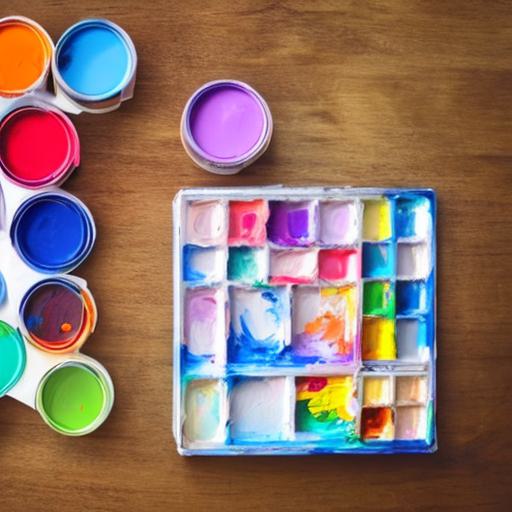Have you ever had a frustrating moment when your acrylic paint starts to dry out mid-project? Fear not! In this article, you will discover some simple and effective techniques to revive your acrylic paint and bring it back to life. Whether you’re a professional artist or just enjoy dabbling in creative endeavors, these tips will save you time, money, and ensure that your artistic vision never goes to waste. So, grab your paintbrushes and let’s revive that acrylic paint!
Gather Materials
To revive your acrylic paint, you will need a few key materials: water, a palette knife, and plastic wrap. These items will help you in the process of refreshing dried-out paint and making it usable again.
Water
Water is an essential component in reviving acrylic paint. It helps to restore the moisture content of the paint, making it easier to work with. Make sure you have access to clean water before you begin the process.
Palette Knife
A palette knife is a versatile tool that can be used for various purposes in painting. In the context of reviving acrylic paint, it is handy for scraping off the top layer of dry paint and mixing it with water or other mediums.
Plastic Wrap
Plastic wrap is crucial for sealing and preserving your paint palette. It helps to prevent the paint from drying out quickly and allows you to revisit your work without wasting any paint. Make sure you have a roll of plastic wrap on hand before you start reviving your acrylic paint.
Check Consistency
Before you start reviving your acrylic paint, it’s essential to check its consistency. This step will help you determine whether the paint needs water or any other mediums to regain its desired texture.
Examine Paint
Take a close look at your dry acrylic paint and assess its condition. Is it extremely dry and solid or slightly dried out but still workable? Understanding the current state of your paint will guide you in deciding the best approach to revive it.
Determine Consistency
The consistency of acrylic paint can vary depending on the artist’s preference and painting style. Some artists prefer thicker paint, while others prefer a more fluid consistency. By determining the desired consistency, you can adjust the amount of water or mediums you need to add to your paint.

Adding Water
Adding water is a simple yet effective way to bring dried-out acrylic paint back to life. By gradually adding small amounts of water and mixing thoroughly, you can restore the paint’s moisture and workability.
Add Small Amounts
Start by adding small amounts of water to your dried acrylic paint. It’s better to add a little at a time rather than pouring in too much water all at once. This way, you can control the consistency and avoid making the paint too thin.
Mix Thoroughly
After adding water, mix the paint thoroughly using a palette knife. Scrape the paint from the palette and the sides of the container, ensuring that the water is evenly distributed. This will help break down any dried clumps and give your paint a smooth, consistent texture.
Using a Palette Knife
A palette knife is a versatile tool that can be a game-changer when reviving acrylic paint. While it is commonly used for mixing paint on the palette, it can also be handy for scraping off the top layer of dry paint and ensuring proper blending.
Scrape Off Top Layer
If you have a layer of dry paint on top of your palette, use the palette knife to scrape it off. This layer can make it challenging to revive the paint beneath it, so removing it will make the process much smoother.
Mix on Palette
After scraping off the dry layer, use the palette knife to mix the paint thoroughly. Scrape the paint from different areas of the palette and fold it onto itself, repeating the process until you achieve a consistent texture. The palette knife’s flat surface allows you to blend the paint effectively and evenly distribute any added water or mediums.

Seal with Plastic Wrap
To prevent your paint from drying out too quickly during your painting session, it’s crucial to seal it with plastic wrap. This technique will help retain moisture, allowing you to revisit your palette without the paint becoming unusable.
Cover Palette
Once you have mixed your paint and achieved the desired consistency, cover your palette with plastic wrap. Make sure all the paint is enclosed within the plastic, leaving no exposed areas. This will create a barrier that prevents air from drying out the paint.
Prevent Drying Out
By sealing your palette with plastic wrap, you create a microclimate that helps retain moisture. The plastic wrap acts as a protective layer, preventing the paint from drying out quickly and giving you more time to work with it. This technique is especially useful if you plan to work on a painting over an extended period.
Moisture Retention Techniques
In addition to sealing your palette with plastic wrap, there are other techniques you can use to retain moisture in your acrylic paint. These techniques are particularly helpful if you’re working with large amounts of paint or need to keep the paint usable for longer periods.
Use a Mist Bottle
One way to keep your paint moist is by using a mist bottle filled with water. Lightly misting the surface of your palette periodically can help prevent the paint from drying out too quickly. Be careful not to add excessive moisture, as it might alter the consistency of the paint.
Place Wet Paper Towel over Palette
Another technique to retain moisture is to place a wet paper towel over your palette. Make sure the paper towel is damp but not dripping wet. The moisture from the towel will transfer to the paint, keeping it moist and workable for an extended period.

Using Acrylic Mediums
In addition to water, you can also revive acrylic paint by using acrylic mediums. These mediums are specially formulated to work with acrylic paint and offer various benefits, such as improving the flow, drying time, or texture of the paint.
Choose the Right Medium
There are numerous acrylic mediums available on the market, each with its unique properties. When reviving your acrylic paint, choose a medium that suits your specific needs. If you want to extend the drying time, a slow-drying medium would be ideal. If you want to alter the texture, consider using a gel medium.
Mix with Dried Paint
To use acrylic mediums for reviving dried-out paint, simply add the desired amount to the dried paint and mix thoroughly. Make sure the medium is evenly distributed throughout the paint to achieve consistent results. The acrylic medium will help restore the paint’s vibrancy and workability.
Replenish Dried Tube Paint
Sometimes, the paint in your tubes can dry out completely, making it difficult to squeeze out or use. To revive dried tube paint, you can employ a simple technique using acrylic medium.
Use Acrylic Medium
Start by squeezing out the dried paint onto your palette. Then, add a small amount of acrylic medium to the dried paint. Mix the contents thoroughly using a palette knife, breaking down any clumps and achieving a smooth consistency. The acrylic medium will add moisture and restore the paint’s ability to flow.
Mix Thoroughly
As with the previous techniques, it’s crucial to mix the dried paint and acrylic medium thoroughly. Ensure that the mixture is free from dry clumps and has a consistent texture. Once mixed, the paint will become usable again, allowing you to continue your painting without wasting any materials.

Reviving Dry Paint on Canvas
Reviving dry acrylic paint on a canvas requires a slightly different approach. Instead of adding water or mediums directly to the paint, you’ll work on the canvas itself to restore moisture.
Spray Water on Canvas
Spray water onto the dry areas of the canvas where you want to revive the paint. Use a fine mist spray bottle to evenly moisten the surface. Be careful not to oversaturate the canvas, as excessive moisture can cause the paint to become too diluted.
Work in Sections
After spraying the water, work in small sections of the canvas at a time. Use a palette knife or a brush to apply fresh paint to the moistened area. The moisture on the canvas will help blend the new paint with the dry paint, allowing you to seamlessly continue your artwork.
Reviving Acrylic Paint: Additional Tips
Reviving acrylic paint can be a rewarding process, but it’s essential to keep a few additional tips in mind to achieve the best results.
Work Quickly
Once you have revived your acrylic paint, work quickly to prevent it from drying out again. Acrylic paint dries relatively fast, so it’s crucial to plan your painting session accordingly and avoid lengthy breaks. If necessary, cover your palette with plastic wrap between painting sessions to retain moisture.
Avoid Water Overload
While water is an effective tool for reviving acrylic paint, it’s crucial to avoid adding too much water. Excessive water can make the paint too thin and alter its consistency and color. Start with small amounts of water and gradually add more as needed, ensuring the paint retains its desired texture.
By following these techniques and tips, you can successfully revive your acrylic paint and continue on your artistic journey. With a little patience and the right materials, you can bring your dried-out paint back to life and create beautiful artworks with ease. Happy painting!



